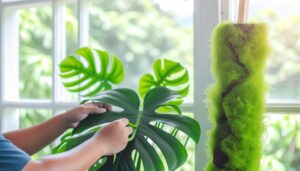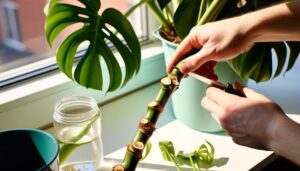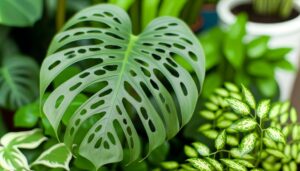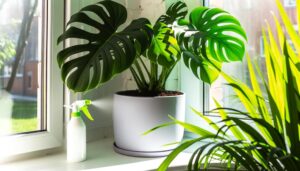How to Care for Monstera Albo Thai Variegation
To care for Monstera Albo Thai Variegation, place it in bright, indirect light, ideally near a north or east-facing window. Water when the top 2-3 inches of soil dry out, using filtered or rainwater.
Keep temperatures between 65°F and 80°F and maintain 60-80% humidity with a humidifier if needed. Use a well-draining soil mix combining orchid bark, perlite, and potting soil.
Fertilize with balanced nutrients and supplement with chelated iron if leaves yellow. Prune during the growing season with sterilized shears.
Combat pests using neem oil. By mastering these fundamentals, you'll support your plant's thriving.

Key Takeaways
- Place the plant in bright, indirect light near a north or east-facing window to avoid direct sun exposure.
- Water when the top 2-3 inches of soil are dry, using filtered or rainwater.
- Maintain temperatures between 65°F to 80°F and humidity levels of 60-80%.
- Use a well-draining soil mix containing orchid bark, perlite, and potting soil.
- Prune during the active growing season, sterilizing shears and cutting above nodes for potential propagation.
Light Requirements
Monstera Albo Thai Variegation needs bright, indirect light to preserve its distinctive variegation and overall health. Position it near a north or east-facing window, making sure that Monstera deliciosa 'Albo Variegata' receives sufficient light without direct sun exposure. Direct sunlight can damage the variegated leaves, resulting in brown, crispy edges.
If natural light is insufficient, utilize full-spectrum grow lights to provide the necessary photosynthetically active radiation (PAR). Maintain a distance of 12-18 inches between the light source and the foliage. Rotate the plant periodically to ensure even light distribution, promoting balanced growth.
Monitoring light levels using a light meter can help you adjust placement, guaranteeing ideal conditions for your Monstera Albo Thai Variegation.
Watering Schedule
To maintain your Monstera Albo Thai Variegation (Monstera deliciosa 'Thai Constellation') health, it's essential to establish an ideal watering frequency that aligns with its natural growth cycle. Typically, water when the top 2-3 inches of soil feel dry, ensuring the root zone remains moist but not waterlogged.
Watch for signs of overwatering, such as yellowing leaves and root rot, to adjust your schedule accordingly.
Optimal Watering Frequency
Determining the best watering schedule for Monstera Albo Thai Variegation requires careful consideration of soil moisture levels and environmental conditions. Begin by evaluating the potting medium, which should be well-draining and rich in organic matter.
Insert your finger an inch into the soil; if it feels dry, it's time to water. Use filtered or rainwater, as this plant, Monstera deliciosa, can be sensitive to tap water's chlorine and fluoride. Adjust watering intervals based on ambient temperature and humidity.
During growing seasons (spring and summer), you'll likely water the plant once a week. In cooler months (fall and winter), reduce the frequency to bi-weekly or even monthly. Always make sure excess water drains to prevent root rot.
Signs of Overwatering
Overwatering symptoms, such as yellowing leaves and mushy stems, indicate that your Monstera Albo Thai Variegation is receiving too much water. Examine the potting medium; if it's overly saturated, root rot (caused by pathogens like Pythium spp.) may set in. Check for a musty odor, another sign of decomposition.
Confirm your Monstera deliciosa 'Albo Variegata' is potted in well-draining soil, like a mix of perlite, orchid bark, and peat moss. Validate that your container has sufficient drainage holes. Allow the top 2-3 inches of soil to dry before watering again. Implement a moisture meter for precise monitoring.
Reduce watering frequency during dormant periods and always adjust based on environmental factors such as humidity and temperature.
Ideal Temperature
Monstera Albo Thai Variegation thrives best in temperatures ranging from 65°F to 80°F (18°C to 27°C). Keep your Monstera deliciosa var. borsigiana 'Albo-Variegata' in a stable environment within this range to promote optimal growth and variegation. Sudden temperature fluctuations can stress the plant, so avoid placing it near drafts or heat sources.
Key considerations:
- Avoid cold drafts: Exposure to temperatures below 55°F (13°C) can damage foliage.
- Monitor indoor temperatures: Use a reliable thermometer to maintain a consistent climate.
- Adjust for seasonal changes: Ensure your heating and cooling systems maintain a stable environment year-round.
Humidity Levels
Maintaining the correct humidity levels is essential for Monstera Albo Thai Variegation. Aim for a relative humidity range of 60-80% to support its epiphytic nature.
To achieve this, you can use a hygrometer for accurate monitoring and employ methods like misting, using a humidifier, or placing a water tray nearby.
Ideal Humidity Range
Maintain the Monstera Albo Thai Variegation thrives by keeping a humidity level between 60% and 80%. This epiphytic plant, Monstera deliciosa var. borsigiana 'Albo-Variegata', demands specific atmospheric moisture to mimic its native tropical environment. Utilize a hygrometer to monitor humidity levels accurately. Inconsistent humidity can lead to browning leaf edges and stunted growth.
- Leaf Integrity: High humidity promotes turgor pressure, essential for the plant's fenestrated leaves.
- Disease Prevention: Proper humidity prevents common ailments like spider mites and fungal infections.
- Growth Optimization: Adequate moisture levels enhance nutrient uptake and photosynthesis efficiency.
Ensure you place the plant in a location with stable humidity and avoid drafts that can cause fluctuations. This will maintain its stunning variegation and lush foliage.
Increasing Humidity Levels
To enhance humidity levels for your Monstera deliciosa var. borsigiana 'Albo-Variegata', consider deploying a humidifier near the plant's location. This device will add moisture to the air, creating an ideal microenvironment.
Alternatively, place the plant on a humidity tray— a shallow tray filled with water and pebbles. Guarantee the pot rests on the pebbles, not directly in water.
Grouping plants together can also increase ambient humidity through collective transpiration. Misting the leaves with distilled water is another method, though less effective long-term.
Always avoid over-watering the soil to prevent root rot (Pythium spp.). Aim for 60-80% relative humidity to mimic the plant's native tropical habitat, promoting robust growth and vibrant variegation in your Monstera Albo.
Humidity Monitoring Tools
For precise humidity monitoring around your Monstera deliciosa var. borsigiana 'Albo-Variegata', invest in a digital hygrometer to accurately track the ambient moisture levels. This device will help you maintain the ideal range of 60-80% relative humidity, essential for the plant's health and variegation. Place the hygrometer near the plant but away from direct sunlight and drafts for precise readings.
Calibration: Regularly calibrate your hygrometer to verify its accuracy.
Consistent Monitoring: Check the humidity levels daily, especially during seasonal changes.
Immediate Adjustments: Be ready to adjust your humidifier or misting routine based on the hygrometer's feedback.
Understanding and maintaining proper humidity levels will greatly enhance the well-being of your Monstera deliciosa var. borsigiana 'Albo-Variegata'.
Soil Mix
A well-draining soil mix for Monstera Albo Thai Variegation should combine equal parts of orchid bark, perlite, and high-quality potting soil to guarantee ideal aeration and moisture retention. Orchid bark (Phalaenopsis bark) promotes good root breathing, while perlite (amorphous volcanic glass) maintains soil structure and drainage. High-quality potting soil, rich in organic matter, supports nutrient availability and water retention.
Here's a breakdown of each component's role:
| Component | Function |
|---|---|
| Orchid Bark | Aeration and root health |
| Perlite | Soil structure and drainage |
| Potting Soil | Nutrient availability |
Mix these components thoroughly to create a balanced medium that mimics the Monstera's natural tropical habitat, promoting healthy growth and variegation preservation.
Fertilizing Tips
Maintaining a nutrient-rich environment is essential, so regular fertilization with a balanced, water-soluble fertilizer like 20-20-20 guarantees Monstera Albo Thai Variegation receives essential macro and micronutrients for ideal growth and vibrant variegation. Apply the fertilizer every 4-6 weeks during the growing season, making sure the soil is already moist to prevent root burn. Dilute the fertilizer to half-strength to avoid nutrient overload and potential chlorosis.
Nutrient Absorption:
Confirm the soil pH is between 5.5 and 7 for best nutrient uptake.
Micronutrient Supplementation:
Include chelated iron (Fe-EDTA) if you notice yellowing leaves.
Seasonal Adjustments:
Adjust fertilization frequency during winter dormancy to maintain balanced nutrient levels.
Following these guidelines guarantees your Monstera thrives with lush, variegated foliage.
Pruning Guide
Pruning your Monstera Albo Thai Variegation is essential for promoting healthy growth, enhancing variegation, and preventing overcrowding.
Start by sterilizing your pruning shears with isopropyl alcohol to avoid spreading pathogens. Identify the stems with excessive variegation (Monstera deliciosa var. borsigiana) and cut just above a node, ensuring the node remains intact for potential propagation.
Remove any yellowing or damaged leaves to direct the plant's energy toward healthier growth. Trim aerial roots sparingly, as they assist in nutrient absorption and stability.
Always prune during the plant's active growing season, typically spring to early summer, to minimize stress. Regular pruning helps maintain an ideal structure and allows better light penetration to all parts of the plant.
Common Issues
Despite your best efforts, Monstera Albo Thai Variegation (Monstera deliciosa var. borsigiana) frequently encounters issues like leaf discoloration, root decay, and pest infestations.
Leaf discoloration often results from improper watering or low humidity. Make sure you're providing consistent moisture without saturating the soil.
Root decay, caused by overwatering, requires well-draining soil and a pot with drainage holes.
Pest infestations, including spider mites and mealybugs, demand prompt action with neem oil or insecticidal soap.
- Leaf Discoloration: Monitor humidity levels; maintain at 60-70%.
- Root Decay: Utilize a soil mix with perlite and orchid bark.
- Pest Infestations: Regularly inspect leaves; address promptly.
Conclusion
By following these guidelines, you'll guarantee your Monstera albo Thai variegation thrives like a star in the botanical galaxy.
Providing ideal light, watering correctly, maintaining perfect temperature and humidity, and using the right soil mix are your building blocks.
Regular fertilizing and mindful pruning keep your plant vigorous.
Address common issues promptly to keep your Monstera in peak health.
Treat it well, and it'll reward you with stunning variegated foliage, turning your space into a verdant paradise.






